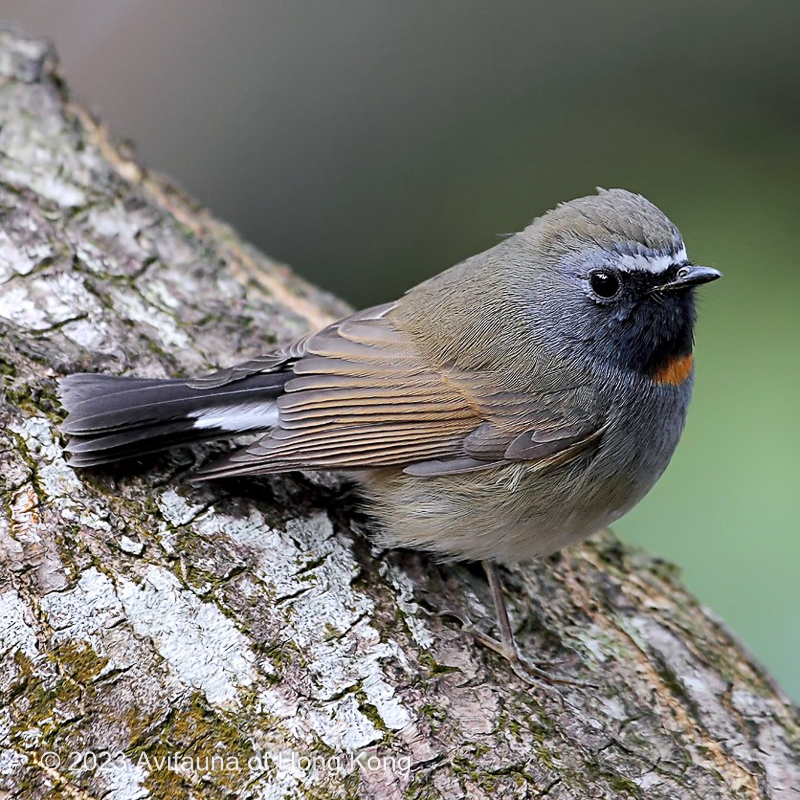Rufous-gorgeted Flycatcher Ficedula strophiata 橙胸姬鶲
Category I. Rare but annual winter visitor to forested areas, often near streams.
IDENTIFICATION

Jan. 2011, Michelle and Peter Wong. Adult male.
13–14·5 cm. In all plumages has black tail with extensive white bases to the outer feathers.
Adult male has a brown crown, white forehead and black face, chin and throat; the centre of the upper breast is orange-red, although this is sometimes unclear or absent. The lower breast is grey, which extends along the side of the neck and borders the black face. The flanks are buffish. The upperparts, including the wings, are brown with warmer brown edges to the flight feathers.

Nov. 2021, Kenneth Lam. Adult female.
The female resembles the male but has a more poorly-marked white forehead and a grey face, chin and throat; the orange patch on the breast, if present, is smaller and duller.

Nov. 2009, Michelle and Peter Wong. First-winter.
First-winter birds may show pale tips to the greater coverts; males and even some females may show a pale rufous throat (and sometimes upper breast) contrasting with pale grey cheeks and breast.
VOCALISATIONS
A repeated high-pitched ‘see’, probably uttered in alarm, has been heard.
DISTRIBUTION & HABITAT PREFERENCE
Occurs in forested habitat, often near streams. Many records are from the closed-canopy forest of the central New Territories, particularly Tai Po Kau, Ng Tung Chai and more recently, Tai Lam Country Park. It has also been recorded at Bride’s Pool, Clearwater Bay Country Park, Lung Fu Shan and on Po Toi.
OCCURRENCE
First recorded at Lam Tsuen on 1 February 1989, it was observed in a further eight winters to 2005/2006. Since 2006/07 it has been a near annual, if rare, winter visitor, probably as a result of increased observer activity. Usually only one bird is recorded per winter but there were four in 2009/10, three in 2010/11 and four in 2017/18.
It has occurred from 23 November to 28 February, although most records are between the beginning of December and the middle of February, with a peak from the last week of January to the second week of February (Figure 1). All sightings have involved single birds apart from two on Po Toi on 28 November 2009 and two at Ng Tung Chai on 30 December 2017. Birds may remain in the same area for three or four weeks; the longest-staying bird on record was a male at Bride’s Pool from 6 January to 12 February 2011.
BEHAVIOUR, FORAGING & DIET
Inconspicuous and elusive. Frequently cocks tail. Forages in low bushes and on the ground for insects.
RANGE & SYSTEMATICS
F. s. strophiata is largely resident across the Himalayas east to northeast India, central and south China, southeast Bangladesh and west and north Myanmar. In China, it breeds from southeast Tibet east to southwest Gansu, Shaanxi, west Hubei, Sichuan, north Guangxi and north and west Yunnan. Some of the breeding population moves south in winter to northeast Bangladesh, south China (west and south Yunnan, Guangxi and Guangdong), central, east and south Myanmar, north Thailand and north Indochina. F. s. fuscogularis is resident in east Laos and south Annam, Vietnam (Clement 2020).
CONSERVATION STATUS
IUCN: Least Concern. Population trend stable.
Figure 1.

Clement, P. (2020). Rufous-gorgeted Flycatcher (Ficedula strophiata), version 1.0. In Birds of the World (J. del Hoyo, A. Elliott, J. Sargatal, D. A. Christie, and E. de Juana, Editors). Cornell Lab of Ornithology, Ithaca, NY, USA. https://doi.org/10.2173/bow.rugfly1.01

